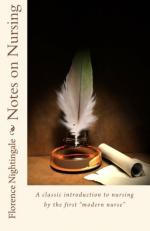But no particle of dust is ever or can ever be removed or really got rid of by the present system of dusting. Dusting in these days means nothing but flapping the dust from one part of a room on to another with doors and windows closed. What you do it for I cannot think. You had much better leave the dust alone, if you are not going to take it away altogether. For from the time a room begins to be a room up to the time when it ceases to be one, no one atom of dust ever actually leaves its precincts. Tidying a room means nothing now but removing a thing from one place, which it has kept clean for itself, on to another and a dirtier one.[1] Flapping by way of cleaning is only admissible in the case of pictures, or anything made of paper. The only way I know to remove dust, the plague of all lovers of fresh air, is to wipe everything with a damp cloth. And all furniture ought to be so made as that it may be wiped with a damp cloth without injury to itself, and so polished as that it may be damped without injury to others. To dust, as it is now practised, truly means to distribute dust more equally over a room.
[Sidenote: Floors.]
As to floors, the only really clean floor I know is the Berlin lackered floor, which is wet rubbed and dry rubbed every morning to remove the dust. The French parquet is always more or less dusty, although infinitely superior in point of cleanliness and healthiness to our absorbent floor.
For a sick room, a carpet is perhaps the worst expedient which could by any possibility have been invented. If you must have a carpet, the only safety is to take it up two or three times a year, instead of once. A dirty carpet literally infects the room. And if you consider the enormous quantity of organic matter from the feet of people coming in, which must saturate it, this is by no means surprising.
[Sidenote: Papered, plastered, oil-painted walls.]
As for walls, the worst is the papered wall; the next worst is plaster. But the plaster can be redeemed by frequent lime-washing; the paper requires frequent renewing. A glazed paper gets rid of a good deal of the danger. But the ordinary bed-room paper is all that it ought not to be.[2]
The close connection between ventilation and cleanliness is shown in this. An ordinary light paper will last clean much longer if there is an Arnott’s ventilator in the chimney than it otherwise would.
The best wall now extant is oil paint. From this you can wash the animal exuviae.[3]
These are what make a room musty.
[Sidenote: Best kind of wall for a sick-room.]
The best wall for a sick-room or ward that could be made is pure white non-absorbent cement or glass, or glazed tiles, if they were made sightly enough.
Air can be soiled just like water. If you blow into water you will soil it with the animal matter from your breath. So it is with air. Air is always soiled in a room where walls and carpets are saturated with animal exhalations.




